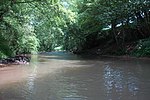Cleobury Town Halt railway station
Disused railway stations in ShropshireFormer Great Western Railway stationsPages with no open date in Infobox stationRailway stations in Great Britain closed in 1938Railway stations in Great Britain opened in 1908 ... and 2 more
Use British English from July 2022West Midlands (region) railway station stubs
Cleobury Town Halt railway station was a station in Cleobury Mortimer, Shropshire, England. The station was opened in 1908 and closed in 1938.
Excerpt from the Wikipedia article Cleobury Town Halt railway station (License: CC BY-SA 3.0, Authors).Cleobury Town Halt railway station
B4363,
Geographical coordinates (GPS) Address External links Nearby Places Show on map
Geographical coordinates (GPS)
| Latitude | Longitude |
|---|---|
| N 52.3898 ° | E -2.4714 ° |
Address
Cleobury Town
B4363
DY14 8HR
England, United Kingdom
Open on Google Maps










